Foundation is one of the essential parts of the structure. It is defined as that part of the structure that transfers the load from the structure constructed on it as well as its weight over a large area of soil in such a way that the amount does not exceed the ultimate bearing capacity of the soil and the settlement of the whole structure remains within a tolerable limit. Foundation is the part of a structure on which the building stands. The solid ground on which it rests is known as the foundation bed.
Why a Foundation is Provided
Foundation should fulfill the following objectives:
- Distribute the weight of the structure over a large area of soil.
- Avoid unequal settlement.
- Prevent the lateral movement of the structure.
- Increase structural stability.
Why There are Different Types of Footing
As we know that there are different types of soil, and the bearing capacity of the soil is different for each type of soil. Depending on the soil profile, size, and load of the structure, engineers chose different kinds of foundations.
Types of Foundation
In general, all foundations are divided into two categories, - shallow and deep foundations. The terms Shallow and Deep Foundation refer to the depth of the soil at which it is placed. Generally, if the width of the foundation is greater than the depth, it is labeled as the “Shallow Foundation”. If the width is smaller than the depth of the foundation it is called a “Deep Foundation.” However, deep foundation and shallow foundation can be classified as shown in the following chart.
The main aspects of different types of foundations, along with their images, are given below. As economic feasibility is one of the main factors in the type selection, it is also discussed briefly with each type. To know other factors that affect the range of foundations read: Factors Considered for Selection of Foundation.
Shallow Foundations
As the shallow foundation depth is low and it is economical, it is the most popular type of foundation for lightweight structures. Several types of shallow foundations are discussed below.
Types of Shallow Foundation
The followings are the types of shallow foundations.
1. Isolated Spread Footing
This is the most widely recognized and most straightforward shallow foundation type, as this is the most economical type. They are typically utilized for shallow establishments to convey and spread concentrated burdens caused, for instance, by pillars or columns. They are generally used for ordinary buildings (Typically up to five stories).
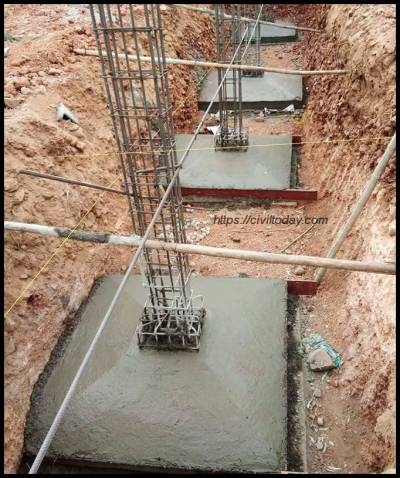
Isolated footing comprises a foundation directly at the base of the segment. Generally, every section has its footing. They straightforwardly transfer the loads from the column to the soil. It might be rectangular, square, or roundabout. It can comprise both reinforced and non-reinforced material. For the non-reinforced footing, however, the stature of the footing has to be more prominent to give the vital spreading of the load. They should possibly be utilized when it is sure beyond a shadow of a doubt that no differing settlements will happen under the whole structure. Spread footings are inadmissible for the orientation of large loads. It is given to lessen the twisting minutes and shearing powers in their primary areas.
The size of the footing can be roughly calculated by dividing the total load at the column base by the allowable bearing capacity of the soil.
The followings are the types of spread footing.
- Single pad footing.
- Stepped footing for a column.
- Sloped footing for a column.
- Wall footing without step.
- Stepped footing for walls.
- Grillage foundation.
To decide when to use shallow foundations, it is necessary to know when it is economical. It is economical when:
- The load of the structure is relatively low.
- Columns are not closely placed.
- The bearing capacity of the soil is high at a shallow depth.
2. Wall Footing or Strip footing
Wall footing is also known as continuous footing. This type is used to distribute loads of structural or non-structural load-bearing walls to the ground in such a way that the load-bearing limit of the soil isn't outperformed. It runs along the direction of the wall. The width of the wall foundation is usually 2-3 times the width of the wall.
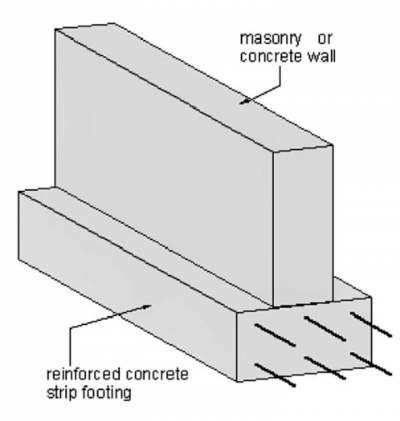
The wall footing is a continuous slab strip along the length of the wall. Stone, brick, reinforced concrete, etc. are used for the construction of wall foundations.
- On account of block walls, the footing comprises a few courses of bricks, the least course being generally double the expansiveness of the wall above.
- On account of stone masonry walls, the counterbalances could be 15 cm, with the statues of the course as 30 cm. Along these lines, the size of the footings is marginally more than that of the block divider footings.
- If the heap on the wall is substantial or the soil is of low bearing limit, this reinforced concrete foundation type can be given.
Wall footing is economical when:
- Loads to be transmitted are of small magnitude.
- It is placed on dense sand and gravel.
3. Combined Footing
The combined footing is very similar to the isolated footing. When the columns of the structure are carefully placed, or the bearing capacity of the soil is low and their footing overlaps each other, combined footing is provided. It is fundamentally a blend of different footings, which uses the properties of various balances in a single footing dependent on the necessity of the structure.
The foundations which are made common to more than one column are called combined footings. There are different types of combined footing, including slab type, slab and beam type, and rectangular, raft, and strap beam type. They may be square, tee-shaped, or trapezoidal. The main objective is the uniform distribution of loads under the entire area of footing, for this is necessary to coincide with the center of gravity of the footing area with the center of gravity of the total loads.
Combined foundations are economic when:
- The columns are placed close to each other.
- When the column is close to the property line and the isolated footing would cross the property line or become eccentric.
- Dimensions of one side of the footing are restricted to some lower value.
4. Cantilever or Strap Footing
Strap footings are similar to combined footings. The reasons for considering or choosing strap footing are identical to the combined one.
In strap footing, the foundation under the columns is built individually and connected by a strap beam. Generally, when the edge of the footing cannot be extended beyond the property line, the exterior footing is connected by a strap beam with the interior footing.
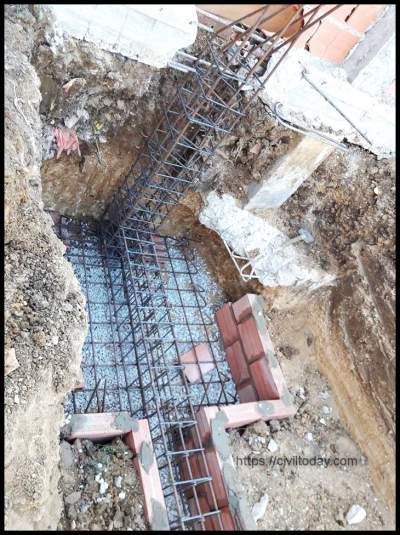
5. Raft or Mat Foundation
Raft or Mat foundations are used where other shallow or pile foundations are not suitable. It is also recommended in situations where the bearing capacity of the soil is inadequate, the load of the structure is to be distributed over a large area, or the structure is subjected continuously to shocks or jerks.
A raft foundation consists of a reinforced concrete slab or T-beam slab placed over the entire area of the structure. In this type, the whole basement floor slab acts as the foundation. The total load of the structure is spread evenly over the entire area of the structure. This is called a raft because, in this case, the building seems like a vessel that floats on a sea of soil.
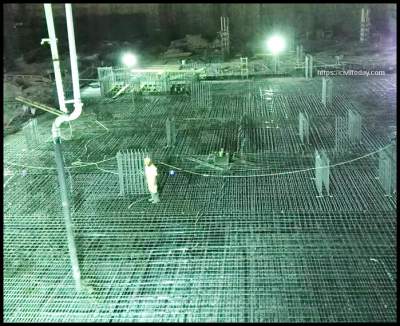
Raft foundations are economic when:
- The soil is weak and the load has to be spread over a large area.
- The structure includes a basement.
- Columns are closely placed.
- Other kinds of foundations are not feasible.
- Differential settlement is to be prevented.
You can also read:
Deep Foundations
Several Types of Deep Foundations Are Discussed Below.
Types of Deep Foundation.
The followings are the types of deep foundations.
1. Pile Foundation
Pile is a common type of deep foundation. They are used to reduce cost, and when as per soil condition considerations, it is desirable to transmit loads to soil strata that are beyond the reach of shallow foundations.
The followings are the types of pile foundations.
- Based on Function or Use
- Sheet Piles
- Load Bearing Piles
- End Bearing Piles
- Friction Piles
- Soil Compactor Piles
- Based on Materials and Construction Method
- Timber Piles
- Concrete Piles
- Steel Piles
- Composite Piles
Pile is a slender member with a small cross-sectional area compared to its length. It is used to transmit foundation loads to deeper soil or rock strata when the bearing capacity of soil near the surface is relatively low. Pile transmits load either by skin friction or bearing. Piles are also used to resist structures against uplift and provide structures stability against lateral and overturning forces.
Pile is a slender member with a small cross-sectional area compared to its length. It is used to transmit foundation loads to deeper soil or rock strata when the bearing capacity of soil near the surface is relatively low. Pile spreads load either by skin friction or bearing. Piles are also used to resist structures against uplift and provide structures stability against lateral and overturning forces.
Pile foundations are economic when
- Soil with great bearing capacity is at a greater depth.
- When there are chances of construction of irrigation canals in the nearby area.
- When it is very expensive to provide raft or grillage.
- When the foundation is subjected to a heavily concentrated load.
- In marshy places.
- When the topsoil layer is compressible in nature.
- In the case of bridges, when the scouring is more in the river bed.
It can again be classified based on its material and its mechanism of load transfer or function. Several types of pile foundations are shown in the following chart.
Pile Foundation Articles
- What is Pile Foundation? Types of Pile Foundation
- Uses of Pile Foundation
- Pile foundation advantages and disadvantages
- Factors Affecting Selection of Pile Foundation Type
- Causes of Pile Foundation Failure
- Difference Between Shallow and Deep Foundation
- What is Friction Pile? Capacity Calculation & Details
- Differences Between Pile and Pier Foundation
- Difference Between Piles, Piers, and Caissons
2. Pier Foundation
Pier is an underground structure that transmits a more massive load, which cannot be carried by shallow foundations. It is usually shallower than piles. The pier foundation is generally utilized in multi-story structures. Since the base region is determined by the plan strategy for the regular establishment, the single pier load test is wiped out. Along these lines, it is increasingly well-known under tight conditions.
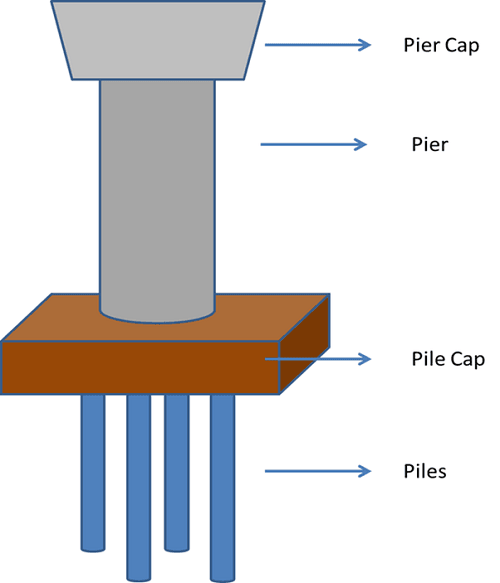
Pier foundation is a cylindrical structural member that transfers heavy load from the superstructure to the soil by end bearing. Unlike piles, it can only transfer load by bearing and by not skin friction.
Pier Foundation is economic when:
- Sound rock strata lie under a decomposed rock layer at the top.
- The topsoil is stiff clay that resists driving the bearing pile.
- When a heavy load is to be transferred to the soil.
Pier foundation has many advantages:
- It has a broad scope of assortment with regard to structure. There are different materials we can here to build a stylish view, and it stays in our spending limit.
- It sets aside cash and time as it doesn't require the broad removal of a ton of cement.
- Bearing limits can increment by under-reaming the base.
Along with the advantages, it has a few disadvantages as well:
- If one post or dock is harmed, it can prompt critical harm to the general establishment.
- It can be vitality wasteful if not protected appropriately.
- Floors must be intensely, vigorously protected, and shielded from critters.
3. Caisson Foundation
Caisson foundation is a watertight retaining structure used as a bridge pier, construction of the dam, etc. It is generally used in structures that require a foundation beneath a river or similar water bodies. The reason for choosing the caisson is that it can be floated to the desired location and then sunk into place.
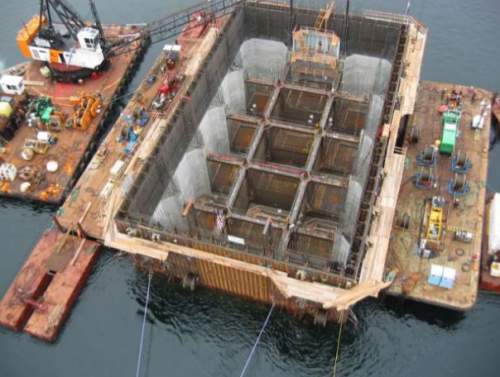
A caisson foundation is a ready-made hollow cylinder depressed into the soil up to the desired level and then filled with concrete, which ultimately converts to a foundation. It is mostly used as bridge piers. Caissons are sensitive to construction procedures and lack construction expertise.
There are several types of caisson foundations.
- Box Caissons.
- Floating Caissons.
- Pneumatic Caissons.
- Open Caissons.
- Sheeted Caissons.
- Excavated Caissons.
Caisson foundations are economic when:
- The pile cap requirement is to be minimized.
- Noise and vibration needed to be reduced.
- It has to be placed beneath water bodies.
- Highly lateral and axial loading capacity is required.
To conclude, the foundation is a structural supporting member that transfers the total load from slab, beam, column, wall, etc. The main objective of the foundation is to provide stability to the total structure and safely transfer the total load from the structure to the soil at an optimum cost.
Sheet Piles
Load Bearing Piles
End bearing Piles
Friction Piles
Soil Compactor Piles
Based on Materials and Construction Method
Timber Piles
Concrete Piles
Steel Piles
Composite Piles

